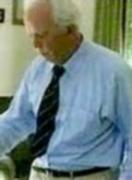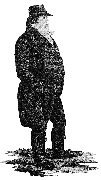|
|
||||||||||||||||||||||||
 |
Featured person
Recently added |
Professor Frank Pantridge (1916 - 2004): |
||||||||||||||||||||||

|
| Professor Frank Pantridge |
Professor Frank Pantridge was a cardiologist whose contribution to that science was of the highest significance; as the inventor of the portable defibrillator, he did perhaps more than any one individual to create pre-hospital coronary care – certainly in his own country, though like many prophets, he was far more quickly accepted outside his own country. The number of lives saved by this device throughout the world is quite simply incalculable.
Pantridge was born in Hillsborough, County Down, and educated at a small preparatory school in nearby Maralin, Downshire School in Hillsborough and Friends’ School, Lisburn, from where he entered Queen’s University, Belfast to study medicine. He graduated in 1939, and on the day after the outbreak of the Second World War he and some colleagues immediately joined the Royal Army Medical Corps.
He was posted to Singapore, the major British base in the Far East, and transferred (as he related it, as a punishment posting for serious insubordination, which did not surprise anyone who knew him) to the Second Battalion of the Gordon Highlanders stationed on Singapore Island. Singapore as well as being a significant commercial centre, famous for its luxurious s Hotel, was also a strategically vital military base that protected Britain’s other Commonwealth possessions in the Far East. Accordingly, it was heavily fortified and regarded as impregnable, though it was assumed any attack would be from the sea, whereas when it was attacked by Japan it was from the land and it fell on February 15th 1942, one of the worst disasters in British military history. Pantridge’s description of British military planning and command was typically highly acerbic, but in this case no doubt accurate. Pantridge himself won one of the few medals awarded during the defence fighting, an immediate Military Cross with the citation that he had “worked unceasingly under the most adverse conditions...an inspiring example...absolutely cool under the heaviest fire and completely regardless of his own personal safety at all times.”
Along with all other military personnel, Pantridge was taken prisoner, though the Japanese did not recognise any Prisoner of War status, and used their “prisoners” as slave labour on railways, usually after marches of hundreds of miles, men in appalling states medically, their treatment brutal. Pantridge’s dispassionate and detailed medical officer’s description of conditions endured by the prisoners includes some statistics, which tell their own story: of the 7000 soldiers in “F Force”, British and Australian soldiers who worked on the Siam-Burma railway, two-thirds did not survive beyond October 1943, most dying of serious illness, untreated with medicine and caused as well as exacerbated by serious malnutrition. In the notorious Tanbaya “hospital camp”, where Pantridge spent two months, Pantridge estimate the survival rate at one-tenth. When Pantridge himself was liberated, a former fellow student described him as having an emaciated upper body, wasted arms, a lower body bloated with the dropsy of beriberi, weighing five stone.
On return to Belfast, he secured a post as a supernumerary lecturer in pathology at Queen’s University and in July 1948 became a medical registrar; he was also awarded a scholarship to study at the University of Michigan under FN Wilson, then probably the leading international authority on electrocardiology. (He was also cardiologist to President Lyndon Johnson, and later Pantridge's defibrillator was used on Johnson when he had a heart attack.) Pantridge returned to Belfast in September 1949, armed with as he put it himself, more knowledge of the electrocardiogram than anyone else in the UK (though he conceded the possibility that one other person in the UK might have known as much as him – that individual was Pantridge’s predecessor in Michigan who had also studied with Wilson.)
Pantridge took up an appointment as physician at the Royal Victoria Hospital, where he began to set up a cardiology unit which would gain an international reputation, notably in the lay press as well as specialist professional medical journals. He became particularly known for one development.
In the mid-1960s, Pantridge turned his mind and energies to the problem of delivering effective treatment to heart attack victims as soon as possible after their onset. At first he was sceptical of the idea, describing as “idiotic”, though that may have been through some not entirely professional antipathy as he linked the idiocy of the idea to an individual Professor, adding that it was not his first such idea. However, it was largely Pantridge who eventually took up the idea and was to run with it most successfully and with what all agreed was a characteristic determination. The figures he found were that the mortality rate for heart attack victims were that 40% die within an hour of the attack, 50% within two hours, and of all heart attacks, 90% were caused by ventricular fibrillation. At this time, the defibrillator was the principal means of treatment of coronary patients, but statistical research, as just indicated, showed that the vast majority of coronary deaths occurred outside hospital. The only defibrillators then in existence were large machines weighing some 150lb, and operated using mains electricity though along with Alfred Mawhinney, a technician, and John Geddes, a senior house officer, it was discovered that could be run from ambulance engine batteries. This solution was the mobile coronary care unit, or MCCU, which like most masterstrokes of invention had a simple basis: to take coronary care by ambulance to the heart attack victim, rather than sending an ambulance merely to transport them to hospital, thus effectively halving the time the victim remained untreated. In addition, he argued that the longer ventricular fibrillation continued, the lesser were the chances of survival, and that any lay individual who was capable of administering cardiopulmonary resuscitation could also be trained to use a simple model of a defibrillator.
He stated too that since life was more important than property, defibrillators should be as widely distributed as fire extinguishers. In contrast to the huge machines in hospitals, Pantridge and his colleagues developed a machine which weighed only 5lb, thanks to their use of a miniature capacitor which had originally been developed for NASA. A later additional feature was a kind of safety catch device which ensured that, if a non-medical person was using the machine, it would automatically refuse to work if it did not detect the presence of ventricular fibrillation – hence avoiding the danger of administering a potentially shock to someone who had, for example, merely fainted.
This, a highly notable invention in cardiology was described by a Professor of Medicine at Queen’s University - one of those present at a meeting in San Francisco of the American College of Cardiology, at which Pantridge demonstrated his invention - as a “seminal moment” and wrote later that:
“Mobile coronary care became an acceptable, though not then an accepted, method of delivering therapy, on Thursday, 29 February 1968, at 1.30 pm...at the Mark Hopkins Hotel in San Francisco, at the American College of Cardiology meeting. Frank Pantridge gave...a presentation, in which he described the work [in Belfast] of the previous year and a half.”
Other tributes to Pantridge’s work included one leading American cardiologist who wrote that: “...the pioneering efforts of Pantridge and his team have revolutionised emergency medical care”; another American expert stated that “the name of Pantridge is known everywhere...from the humblest ambulanceman in the inner city ghetto emergency service to the most erudite members of university faculties. Professor Pantridge’s name is so well known that literally he could run for political office.”
Of course there has been much development since then of Pantridge’s work, but without any doubt it was principally this invention which made him of the most significant cardiologists in the world. Curiously, he was at first without honour in his own country, where, in complete contrast to the United States, his ideas were very slow to become accepted As a personality, Pantridge was seen by some as slightly abrasive. In the words of another Professor of Medicine at Queen’s University, he “had a veneer of arrogance at times but this often concealed an innate shyness. On a good day he looked as though he owned the world, on a bad day he looked as though he didn’t care who owned it...[his] clicked fingers acted as punctuation and the stiff index finger directed the verbal missile.”
His numerous honours and distinctions included being appointed, Fellow of the Royal College of Physicians in 1957; CBE in 1978; Fellow of the American College of Cardiology in 1967; he was Director, Regional Medical Cardiology Centre Northern Ireland, 1977-82 and an Honorary Professor of Cardiology at Queen’s University, Belfast. Additionally, he was St Cyres Orator at the Canadian Heart Foundation; Chairman of the British Cardiac Society in 1978, an Honorary Fellow of the Royal College of Physicians in Ireland, and was awarded honorary degrees from the Open University and the New University of Ulster. His potrait, executed by Martin Wedge, is on display in the Great Hall of Queen's University, Belfast.
His publications, apart from numerous academic papers, included his autobiography, which ran to three editions, and contains many reminiscences of interest to the layman as well as the physician, and in which he made no secret of his direct (to say the least) way of dealing with certain people. The third edition had a dust-jacket cover featuring an image, not of Pantridge himself but quite simply, of his portable defibrillator.
| Born: | 3 October 1916 |
| Died: | 26 December 2004 |
| Richard Froggatt |
| Acknowledgements: Wesley McCann |
| Bibliography: Frank Pantridge: An Unquiet Life; various obituaries (The Times; The Independent; The Guardian; British Medical Journal); John S Geddes: The Management of the Acute Coronary Attack: The J Frank Pantridge Festschrift |


Home | Our Policies | Plaques | Browse | Search | Sponsors | Links | Help | Contact
Privacy & Disclaimer | Cookie Policy | Site Map | Website Design By K-Point
© 2024 Ulster History Circle









